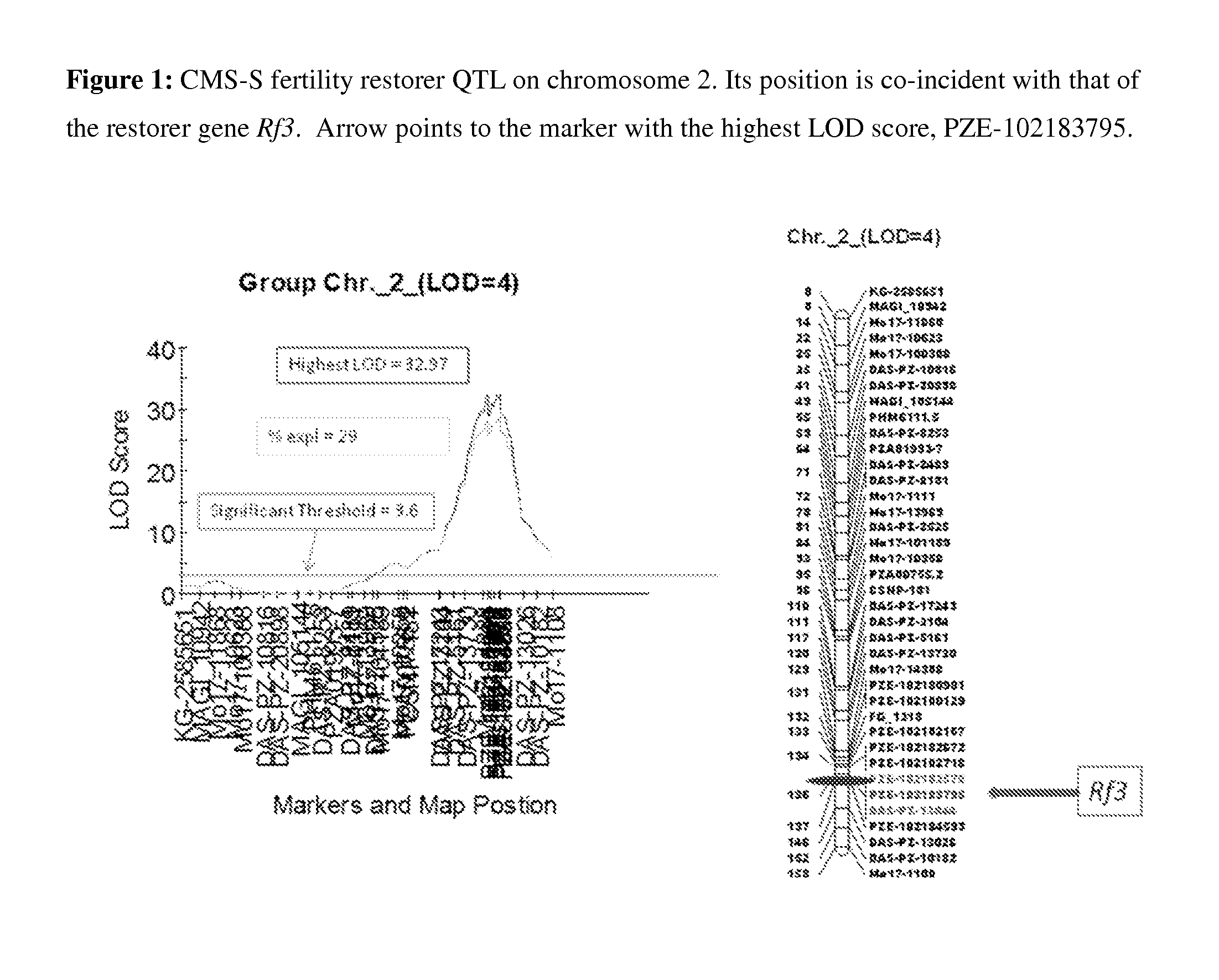MAIZE CYTOPLASMIC MALE STERILITY (CMS) S-TYPE RESTORER Rf3 GENE, MOLECULAR MARKERS AND THEIR USE
a technology of maize and cytoplasm, applied in the field of rf3, a maize restorer of fertility gene, can solve the problems of plants tasseling, labor-intensive and costly manual detasseling, and ineffective manual detasseling
- Summary
- Abstract
- Description
- Claims
- Application Information
AI Technical Summary
Benefits of technology
Problems solved by technology
Method used
Image
Examples
example 1
Plant Material
[0117]A male sterile line of CMS-S type, 4XP811-D (U.S. Pat. No. 7,135,629), and a male sterile restorer line responding to CMS-S type, LH60, were used as parents to generate F1 progeny. The F1 progeny where then selfed to generate an F2 population. The F2 population, consisting of 450 individuals, was used for identification of the Rf3 gene and markers linked (e.g., linked; tightly linked; or extremely tightly linked) to the Rf3 gene.
[0118]A BC1 population of 275 individuals derived from 4XP811-D x MBB56, a male sterile restorer line responding to CMS-S type, was used for linkage map analysis with molecular markers designed from the 10 PPR genes within the 1.3 Mb interval.
example 2
Fertility Classification
[0119]The individuals from the F2 and BC1 populations were phenotypically classified according to pollen shed from the tassels. Plants that shed pollen were classified as fertile. Plants that did not shed pollen were classified as sterile. Partial fertile plants were observed in the F2 population but not in the BC1 population.
[0120]The individuals from the BC1 population were also phenotypically classified by determining the vitality of pollen grain by using 1% KI-I2 staining. For the fertile plants, the staining results show well stained pollen that were starch-filled and for the sterile plants, the staining results show un-stained collapsed pollen. Table 1 provides the segregation data from the F2 and BC1 mapping populations.
TABLE 1Phenotypic segregation data from the F2 and BC1 mapping populationsSemi-fertileNon-pollinatedPopulationSizeFertile plantsplantsSterile plantsplantsBroken plantsF2450347732442BC12751390120016
example 3
DNA extraction and Quantification
[0121]Genomic DNA was extracted from 8 leaf punches per sample using the MagAttract™ DNA extraction method (Qiagen, Valencia, Calif.) and the Biocel 1800™ (Agilent Technologies, Santa Clara, Calif.). DNA samples were quantified with Quant-iT™ PicoGreen® Quantification Kit (Invitrogen, Carlsbad, Calif.) per manufacturer's instructions or with the Nanodrop 8000 Spectrophotometer™ (Thermo Scientific, Rockford, Ill.) per manufacturer's instructions. The DNA concentration was normalized to 6 ng / μL for use in the KASPar™ genotyping system (KBioscience Inc., Hoddesdon, UK).
PUM
| Property | Measurement | Unit |
|---|---|---|
| Digital information | aaaaa | aaaaa |
| Digital information | aaaaa | aaaaa |
| Digital information | aaaaa | aaaaa |
Abstract
Description
Claims
Application Information
 Login to View More
Login to View More - R&D
- Intellectual Property
- Life Sciences
- Materials
- Tech Scout
- Unparalleled Data Quality
- Higher Quality Content
- 60% Fewer Hallucinations
Browse by: Latest US Patents, China's latest patents, Technical Efficacy Thesaurus, Application Domain, Technology Topic, Popular Technical Reports.
© 2025 PatSnap. All rights reserved.Legal|Privacy policy|Modern Slavery Act Transparency Statement|Sitemap|About US| Contact US: help@patsnap.com


